Garden Party Address
June 10, 2008
Joel Seligman
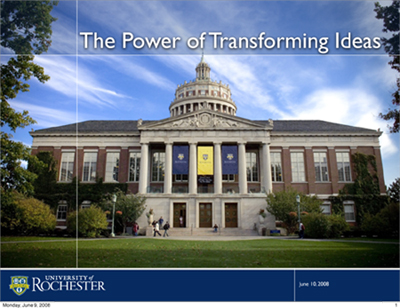
Good evening. I want to make a different type of speech this year. In the past two years I have spoken about the University in the community. This remains a vital topic that I will discuss at the conclusion of tonight’s remarks.
But tonight I want to stress the role of the University of Rochester as one of this nation’s leading research universities and why this matters to all of us. I do not want to emphasize statistics, which are abstractions, but talk about the human beings who are the teachers, scholars and researchers who have been pivotal to the progress of this University.
Research universities are the most significant United States contribution to higher education. Each research university combines a liberal arts approach to undergraduate education with graduate and professional schools and often a medical center. While this nation had 4,314 universities and colleges in 2007, only 62 universities, including the University of Rochester, are members of the Association of American Universities which is the national organization of this country’s leading research universities.
Research universities matter most because of their ability to teach and publish what our former Provost Chuck Phelps and former Associate Vice President for Public Relations Robert Kraus called “transforming ideas.” Research universities succeed when talented scholars and scientists use their creativity and hard work to help transform their fields in science, social sciences, engineering, medicine, professional schools, humanities and the arts. Throughout our history, the University of Rochester has established its reputation because of thought leaders like:
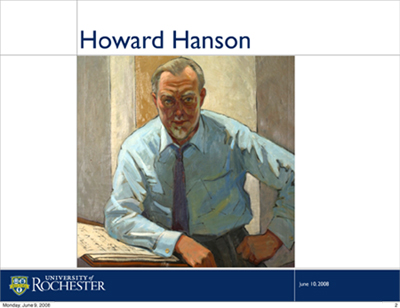
Howard Hanson, who was Dean of the Eastman School for 40 years and revolutionized the teaching of music by, among other things, championing the study of American music.
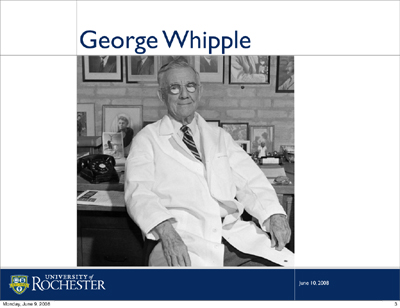
Dr. George Whipple, founding Dean of the University’s School of Medicine and Dentistry, who earned the Nobel Prize in 1934 for key discoveries that helped identify a cure for anemia.
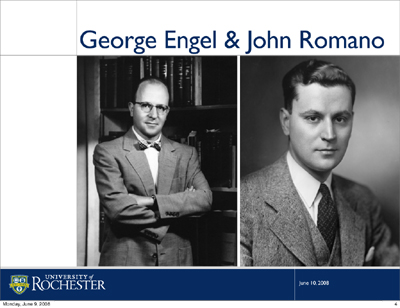
Doctors George Engel and John Romano who developed the School of Medicine and Dentistry’s biopsychosocial model to consider all of a patient’s relevant biological, psychological and social factors, not just their specific disease.
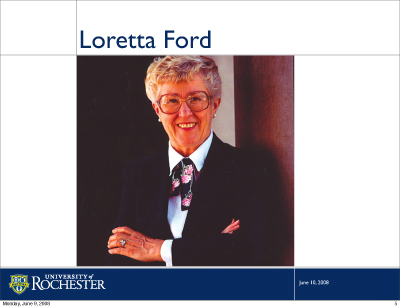
Loretta Ford, the first Dean of the School of Nursing, who transformed the teaching of nursing through the unification model that simultaneously addresses clinical care, education and research.
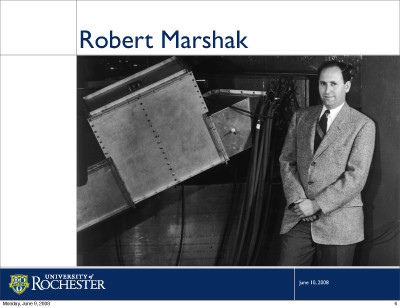
Physicist Robert Marshak, who made the name Rochester synonymous with high energy and nuclear physics, areas pivotal to national defense during and after World War II.
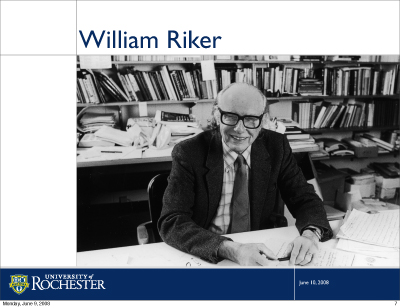
William Riker, who created a new model for the study of political science, that emphasized quantitative analysis and methodological rigor.
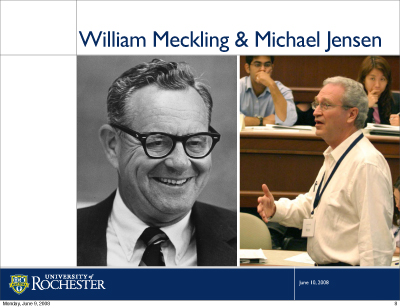
Former Simon School Dean William Meckling and Professor Michael Jensen who redefined the modern study of corporate finance and helped create the field of law and economics with seminal articles like “Theory of the Firm: Managerial Behavior, Agency Costs, and Ownership Structure.”
Research universities make their contribution to society through the power of ideas. They do this through teaching, research and scholarship. It is the quality of what we think or write that leads to graduates capable of being leaders in our society, making discoveries that cure disease or offer new forms of therapy, creating new sources of energy, or new ways of applying basic research to address urgently felt human needs. Transforming ideas are not limited to science, engineering and medicine. This University has made vital contributions to the humanities, social sciences, and performing arts. A great research university is both a laboratory that envisions our future and a repository and teacher of the wisdom that has stood the test of time.
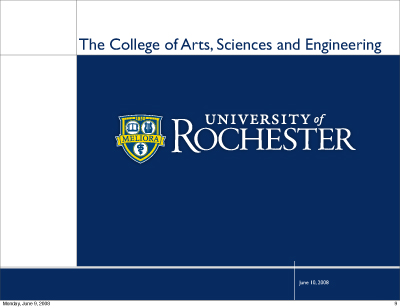
Our College of Arts, Sciences and Engineering is among the nation’s leaders in several specific fields, including optics, visual and cultural studies, biomedical engineering, political science, economics, physics and astronomy. Let me describe the work of a few of the College’s outstanding professors.
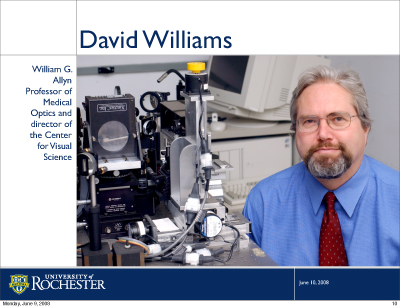
David Williams, the William G. Allyn Professor of Medical Optics, has taken a technology used by astronomers to look deep into space and has applied it to see the human eye more clearly than ever before. The technique is known as adaptive optics. David and his colleagues have designed a camera that uses this technology to take pictures of structures as small as single cells at the back of the living eye.
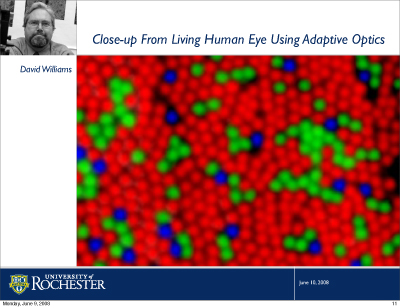
The new approach is now used at dozens of research laboratories around the world, including the University of Rochester Eye Institute, to study blinding diseases such as glaucoma, retinitis pigmentosa, age-related macular degeneration, and diabetic retinopathy.
David’s team also is using adaptive optics to allow people to see more clearly. Their technology provides a detailed description of the optical defects in a person’s eye that make possible customized contact lenses and refractive surgery.
In 2003 and in 2007 David was recognized byR&D Magazinefor having one of the 100 most technologically significant inventions of the year.
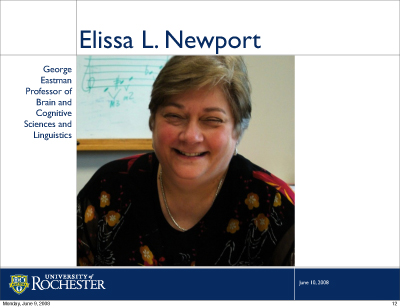
Elissa Newport, the George Eastman Professor of Brain and Cognitive Sciences and Linguistics, has spent her career answering critical questions about one of the great mysteries of the human brain – how we acquire language. Elissa’s research suggests that by the time a child reaches the age of four, the innate ability to learn language fluently begins to diminish.
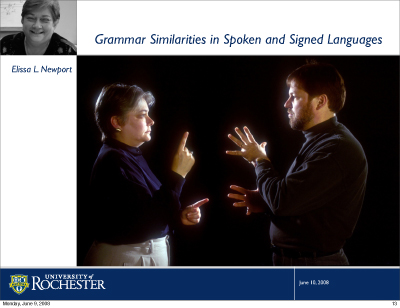
Along with Professor Ted Supalla, Elissa also has taken a closer look at why both spoken and signed languages around the world exhibit similar grammar characteristics. She studied children in Nicaragua, Japan, Israel, and the United States who were not exposed to formal language early in life and developed their own form of self-taught language. The results suggest that how we learn language may be strongly connected to the way the human brain actually functions. This finding could shed new light on treatments for brain injuries, such as stroke, that impair speech.
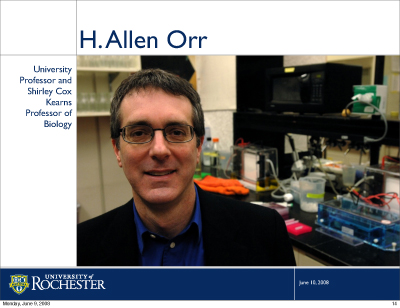
On the 200th birthday of Charles Darwin, February 12, 2009, Allen Orr, University Professor and Shirley Cox Kearns Professor of Biology, will be awarded a Darwin-Wallace Medal for one of the “major advance[s] in evolutionary biology since 1958.” This medal is awarded every 50 years to commemorate the reading of the historic Darwin-Wallace paper on Natural Selection at the Linnean Society of London.
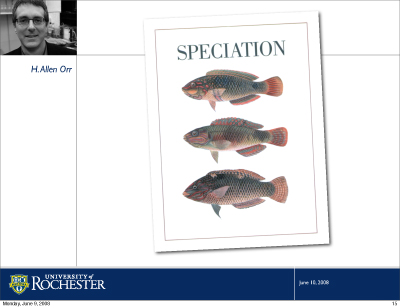
In 2006 the journal Science selected a paper by Allen, coauthored with graduate student J.P. Masly, as one of the top ten science breakthroughs of the year. Allen and his team discovered an alternative process through which speciation, or the creation of different species, begins. New species can be triggered by genes that change their locations in a genome. This is an important step toward a better understanding of how new life forms begin and why there is such an amazing diversity of life on our planet.
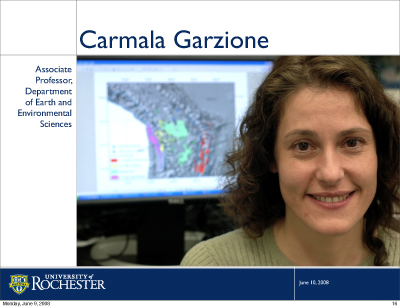
Carmala Garzione, working with colleagues from Cal Tech, has pioneered an approach to the study of mountain growth, that reveals gradual growth is interspersed with periods of very rapid growth.
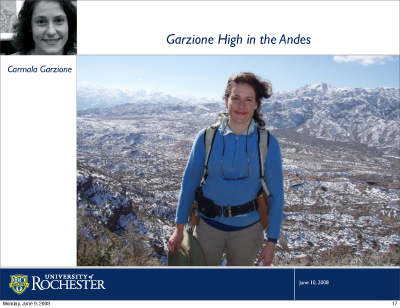
Focusing on the Andes, their work has shown that relatively stable growth over tens of millions of years alternates with periods during which mountains can literally double their height in as few as two to four million years. The fact, as Carmala puts it, that mountains can “pop up so quickly” might affect climate and is leading to a revision of our understanding of tectonic process. For her advances in paleoelevation, Carmala was awarded the Donath Medal of the Geological Society of America, recognizing her as the outstanding Young Scientist in 2007.
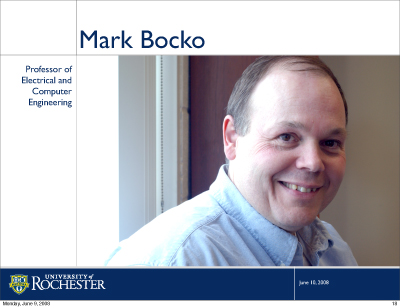
Mark Bocko, a pioneer in the field of supercomputing, recently drew international attention for digitally reproducing music in a file nearly 1,000 times smaller than a regular MP3 file. This breakthrough will someday allow musicians anywhere in the world to perform together live with virtually no delay in sound.
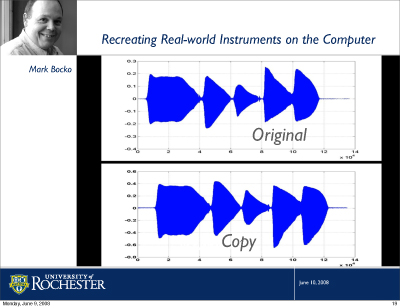
Mark was able to achieve this remarkable feat by recreating in a computer both the real-world physics of a clarinet and the physics of the clarinet player. Mark and his team are now perfecting this recording approach as part of a project funded by the National Science Foundation.
Mark’s work also addresses medicine. As technical director of the Center for Future Health, Mark works with six private companies to explore ways in which smart sensors can be used to enhance personal health. Tiny wearable monitors may one day continuously collect signals from the body and transmit data to a base station in the home thanks to the refinement of this new technology.
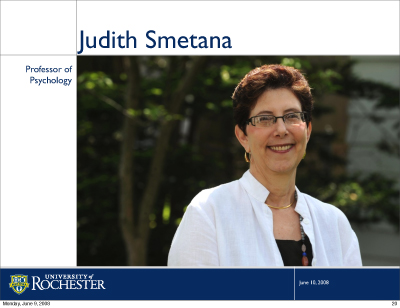
Judi Smetana is a developmental psychologist who has won international respect for her work on how children construct their moral universe and on the relationships between adolescents and their parents.
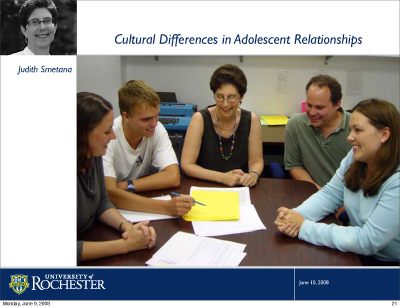
Judi is part of a new wave of social scientists who are examining these issues from multicultural points of view. Most recently, she and her research team, with support from the National Science Foundation, conducted several studies to learn more about the ways in which adolescents talk to their parents. The work included a daily-diary study of Latino, African-American, and European-American high school students. Her research highlights that all teens, regardless of ethnicity, seek independence, but there are important cultural differences in the strategies that teens use to assert their autonomy.

Anthea Butler is known nationally for her writings and teachings on evangelicalism and fundamentalism, particularly the Pentecostal movement. She recently received a 2008–09 research scholarship from the Women Studies in Religion Program at the Harvard Divinity School to continue work on a forthcoming book that chronicles the life of a Baptist missionary whose interracial work during the second half of the 19th century helped African Americans in the South learn how to read.
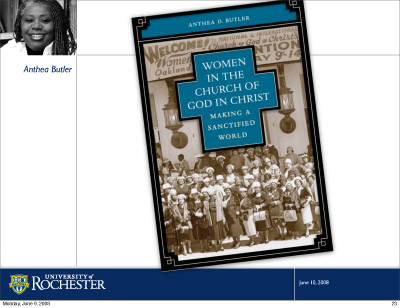
Anthea’s book,Women in the Church of God in Christ: Making A Sanctified World, is the first major study of the largest Pentecostal denomination in the United States.
National Public Radio has called on Anthea frequently as an expert on such topics as the role of the African-American preacher in American society, Pentecostalism, the art of the sermon, and most recently mega-churches and “prosperity religion.”
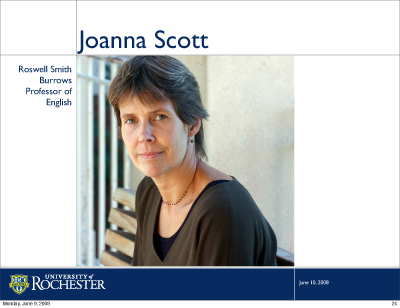
Joanna Scott, the Roswell S. Burrows Professor of English, has earned critical acclaim for her novels and short stories. Joanna is the recipient of a MacArthur “genius” grant and a Guggenheim fellowship. In 1997 she was a finalist for the Pulitzer prize for her novel,The Manikin.
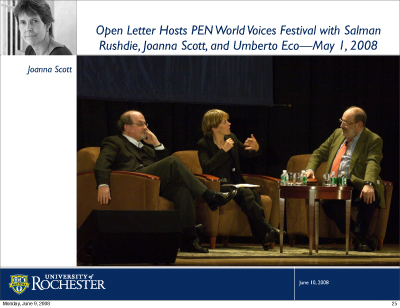
Joanna teaches fiction writing and modern literature at the University. She has played an integral role in helping start the University’s new literary translation press, Open Letter, which last month hosted authors Salman Rushdie and Umberto Eco in a reading and conversation moderated by Joanna. Joanna also has been deeply involved in planning and implementing newly instituted undergraduate and graduate programs in Literary Translation.
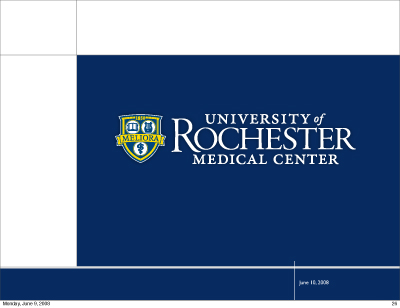
Let me turn now to a second great center of the University of Rochester. The School of Medicine and Dentistry and the School of Nursing are among this nation’s leaders in several research areas, including neuroscience, clinical and translational research, orthopedics, dentistry, and in specific areas in vaccine biology, cancer, and cardiovascular science.
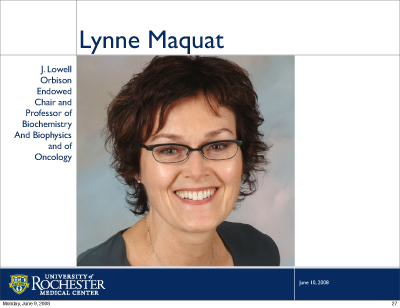
Lynne Maquat, the J. Lowell Orbison Endowed chair, performs research that goes to the heart of a mystery that has puzzled scientists: Why do humans—the most complex organism on Earth—have so few genes compared to much simpler organisms? People, for example, have one-fifth as much genetic material as a grain of wheat.
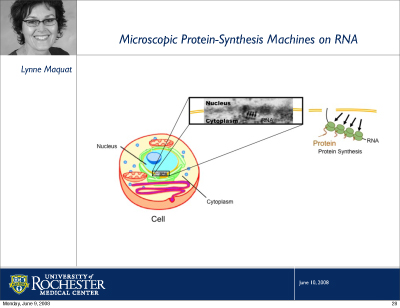
Part of the answer is that humans do more with fewer genes. While genes consist of chains of DNA, they receive their marching orders from another molecule called messenger RNA. Mistakes involving messenger RNA can lead to a multitude of diseases. The body’s quality control system designed to destroy flawed RNA is crucial to our health. Lynne’s team has revealed the existence of a natural surveillance and editing system that determines which messenger RNA are healthy and which are flawed and must be destroyed. Adapting the process to catch more genetic errors opens the door to new and revolutionary ways to treat genetic disorders.
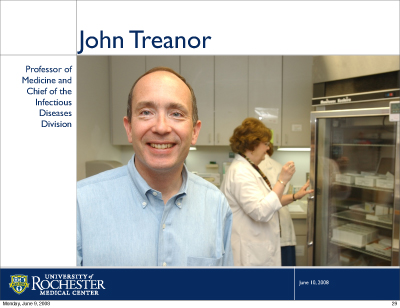
John Treanor is in the vanguard of efforts to protect people around the globe from infectious diseases such as bird flu, whooping cough, and the common cold.
For more than 20 years, University of Rochester researchers have helped lead a “vaccine renaissance.” Our researchers have developed new vaccines that protect millions of people from deadly illnesses, including bacterial meningitis, and helped create the new cervical cancer vaccine, the first vaccine against any of the 260 different types of cancer.
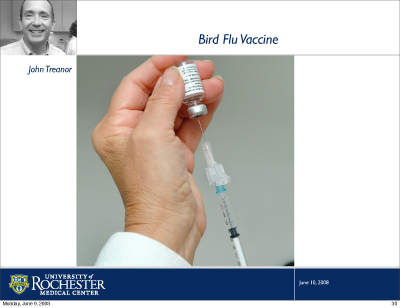
John Treanor has played a leading role in the nation’s efforts to find a vaccine to protect against bird flu. Largely as a result of his work, the first vaccine against the disease became available in our country last year. Time Magazine cited the approval of the bird flu vaccine as the top medical development in 2007.
Recently John founded the New York Influenza Center of Excellence, designed to protect people against seasonal flu and future flu pandemics. This Center was awarded $26 million by the National Institutes of Health in April 2007.
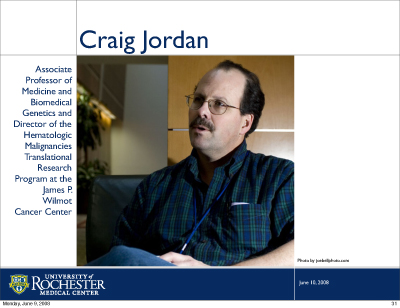
The University of Rochester also is home to several leading research programs in the field of stem cell biology. There are currently 40 scientists in Rochester working with stem cells, whose labs employ more than 230 people and are funded with $78 million in active grants.
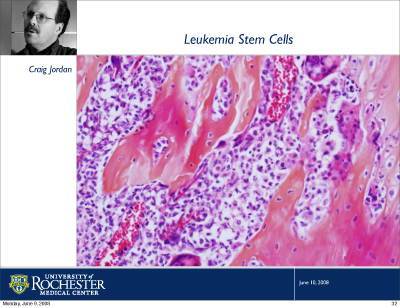
Craig leads a team that is developing a new leukemia treatment. Derived from feverfew, a daisy-like plant, this compound will soon be tested in human clinical trials. In early laboratory studies it has shown great potential, resulting in the National Cancer Institute accelerating its development through the Institute’s rapid access drug program.
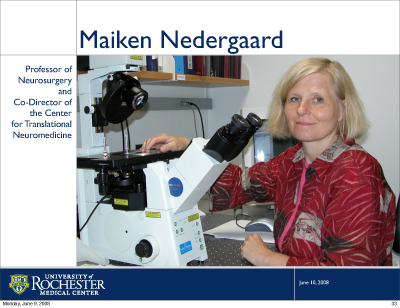
Maiken Nedergaard’s pioneering work in neuroscience focuses on brain cells known as astrocytes that were long considered passive support cells. Maiken has discovered what might be called the secret lives of astrocytes and made a series of startling discoveries showing that astrocytes play a role in a range of conditions, including stroke, Alzheimer’s disease, epilepsy, cerebral palsy, cancer, spinal cord injury, brain tumors, and migraine headaches.
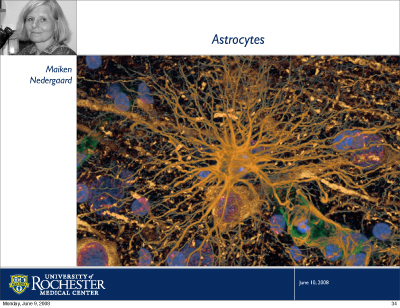
Pivotal to these discoveries was Maiken’s research into an area of neuroscience many considered obsolete. For decades, scientists focused on detecting the electrical activity of neurons, but had little success using these techniques to detect the activity of astrocytes. Astrocytes have a different way of communicating, not captured by conventional technology. Maiken developed a sophisticated laser system that has revealed unprecedented images of the living brain and of the activity of astrocytes. This insight may prove pivotal to creating new treatments for diseases such as Alzheimer’s.
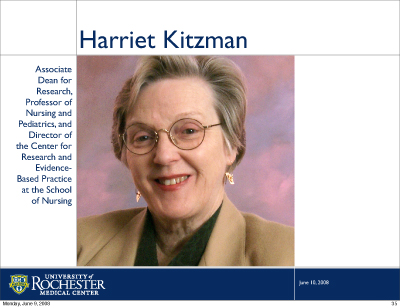
Harriet Kitzman has spent more than 30 years conducting research to improve the lives of women and children. Last week Harriet was awarded $6.5 million from the National Institute on Drug Abuse to investigate the long-term benefits of nurse home visits for at-risk mothers and their children. This is the largest single research award in the School of Nursing’s history. Harriet’s research has shown that nurse home visits can result in mothers having healthier pregnancies, more stable relationships, fewer closely spaced pregnancies and ultimately less reliance on government assistance.
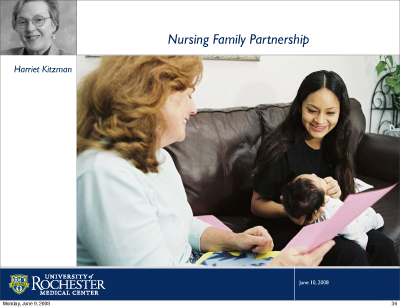
Harriet’s research also has led to the development of the Nurse Family Partnership, a national nonprofit organization that operates in more than 20 states. The Nurse Family Partnership promotes self-sufficiency among young struggling families. In Monroe County, more than 200 families are currently enrolled in this Partnership. It has been estimated that this Partnership will save Monroe County taxpayers more than three dollars for every dollar invested by the time a child is 16 years old.
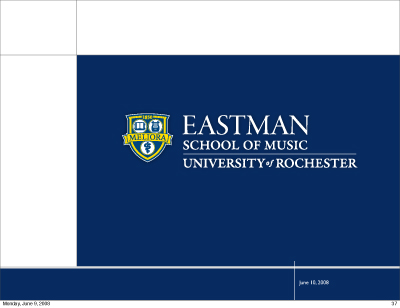
In 2007, the Eastman School of Music was recognized by Kaplan/Newsweek as the hottest school of music in the country. Earlier US News published rankings have rated Eastman as this nation’s leading graduate music program. These are fitting recognitions of a school that continues to redefine the study of music through generations of new programs such as the recently created Eastman Institute for Music Leadership.
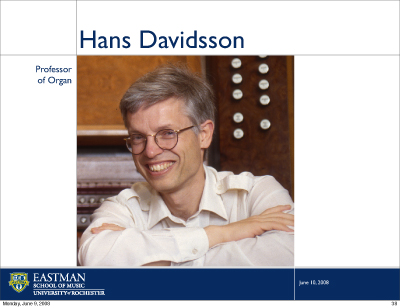
Hans Davidsson is overseeing the Eastman-Rochester Organ Initiative or EROI, a 10-year plan to establish a broad program in historical organ performance, scholarship and organ restoration here in Rochester and to assemble a collection of new and historical organs unparalleled in North America. Many schools have great programs in organ performance, but EROI has made the Eastman School of Music an international leader.

As part of the organ initiative, Hans directed the installation of the Italian Baroque organ here at the University’s Memorial Art Gallery. The MAG now houses the only full-size Italian Baroque organ in North America.
Hans is also overseeing the installation of another remarkable instrument: a 15-ton precise replica of a 1776 Lithuanian organ in Lithuania. It is the culmination of a six-year research project involving organ builders, scientists, and scholars from six countries. The organ is now being installed in Christ Church, making Rochester the only city in the United States to house a replica of this 18th-century instrument.
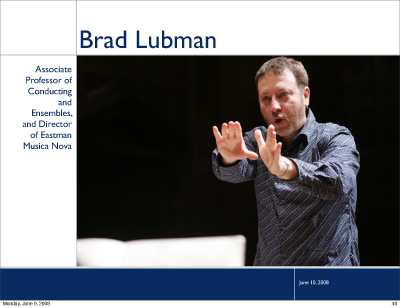
Conductor and composer Brad Lubman is one of the world’s leading conductors of modern music. Since joining the Eastman faculty in 1997, Brad has served as music director of Musica Nova. In the past season alone, Brad made his debut with the Symphony Orchestra in Cologne, Germany, the Chicago Symphony MusicNOW, and the Netherlands Radio Philharmonic.
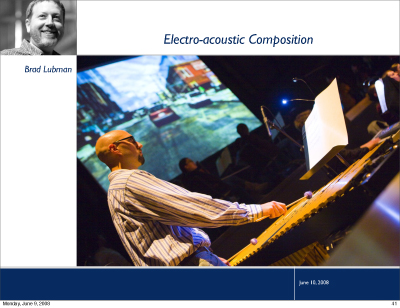
Brad is also a distinguished composer of complex electro-acoustic compositions. His music has been performed in the United States and Europe. This summer, Brad’s new group, Signal, will debut at the prestigious Ojai Festival in California.
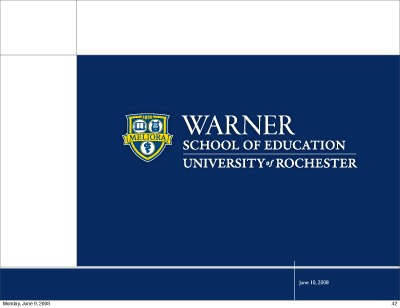
Lucia French, the Earl B. Taylor Professor of Education, has garnered national attention for her work on a science-based preschool curriculum. SLIDE 43
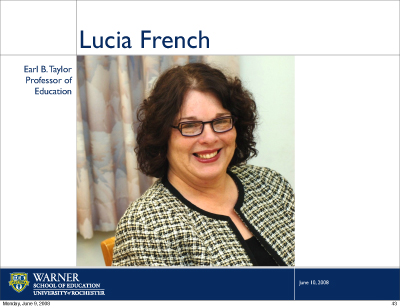
Initial funding from the Eastman Kodak Company’s 21st Century Learning Challenge in 1991 allowed Lucia to develop ScienceStart!, which embraces science as an essential part of preschool.
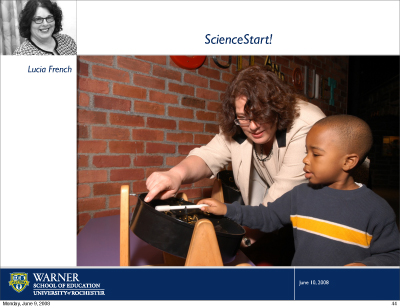
Lucia has received major grants from the National Science Foundation and the United States Department of Education to field test and expand this curriculum. A grant from the Department of Education’s Early Reading First program, for example, established Rochester preschools as centers of educational excellence. Lucia is in the vanguard of several efforts at Warner to strengthen literacy, science and math education.
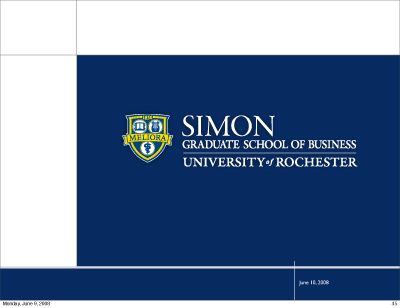
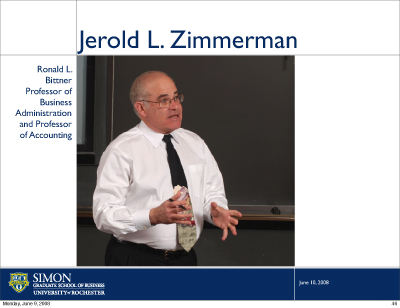
Jerry’s early work with former Simon School Professor Ross Watts earned what is considered the Nobel Prize of Accounting—the American Accounting Association’s award for Seminal Contribution to Accounting Literature. They received the honor for a groundbreaking 1978 paper that helped establish accounting as an academic field.
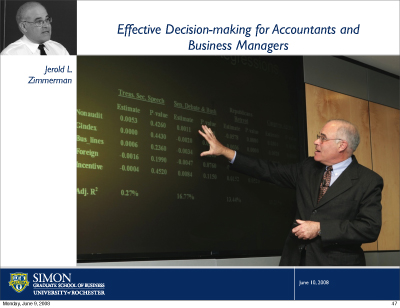
Jerry’s work provides a framework that has changed the focus of accounting research from how managers should make accounting-related decisions to how managers do in fact make these decisions. He is the editor of a leading accounting publication, theJournal of Accounting and Economics.
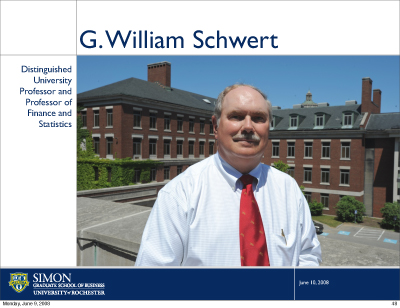
Bill Schwert, Distinguished University Professor, is a national leader in stock market movements or volatility. Bill draws on economics, finance and statistics for research that has been frequently sponsored by the National Science Foundation. He is the editor of theJournal of Financial Economics, the leading academic journal in its field.

Bill’s research deals with the pricing of new stock offerings, the effects of insider trading on the market for corporate control, and the effects of anti-takeover devices on corporate takeover activity. His influential work has been cited more than 4,000 times in books and journal articles.
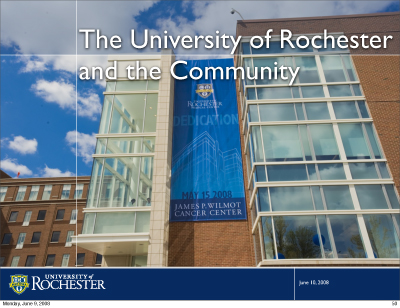
In all, there are approximately 1250 tenured and tenure track professors at the University of Rochester. In some instances, their research and care directly leads to advances that touch the lives of people around the world and have a direct impact in Rochester and upstate New York.
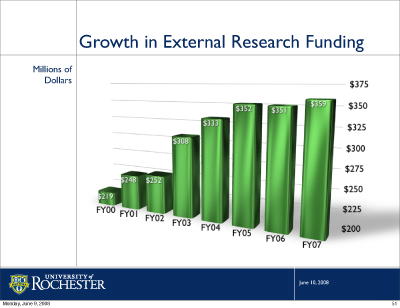
Research funding awards are the most significant indicator that our scientists and scholars are engaged in work that may yield transformative discoveries. Between 2000 and 2007, University of Rochester external research funding grew from $219 to $359 million to support thousands of active research projects in medicine, optics, engineering, and other high-tech fields.
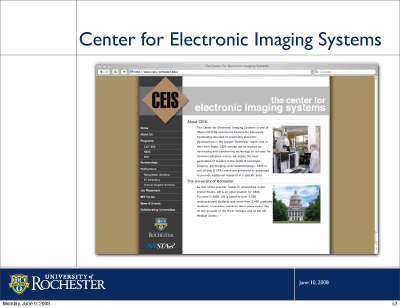
Similarly, in November 2007, the University’s Center for Electronic Imaging Systems was able to help generate a record of $120 million revenues in New York State for such projects as space-faring telescopes, medical devices, digital cameras, and remote sensing technology for military drones.
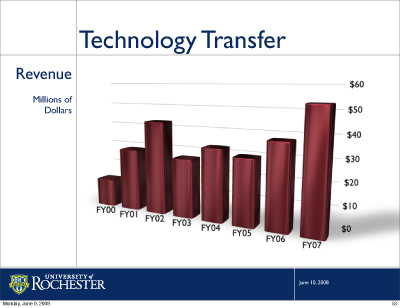
The University has a proven track record of moving advancements out of the lab and into the marketplace where they can benefit us all. For the past six years, we have been among the top 10 universities in the country in terms of the royalty revenue we receive from our licensed technologies. In 2007 our research generated $53 million.
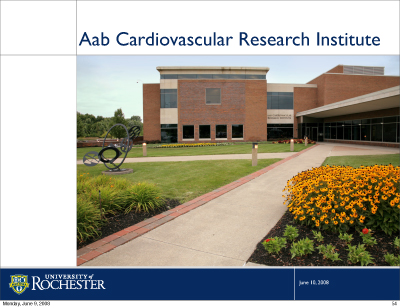
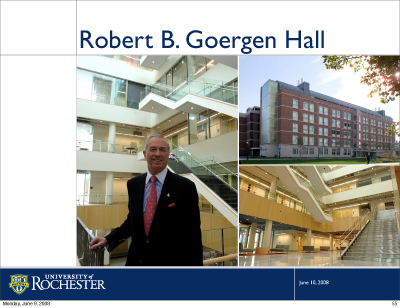
the Robert B. Goergen Hall for Biomedical Engineering and Optics that was dedicated in May 2007. These types of facilities provide the vital laboratory space necessary for path breaking research to occur.
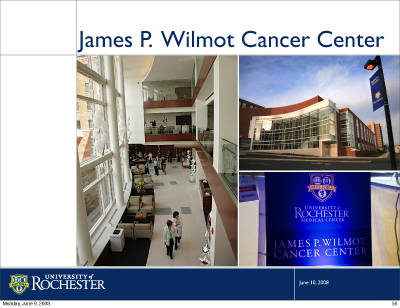
More recently, on May 15 of this year, we celebrated the opening of the new James P. Wilmot Cancer Center and the successful completion of a $42.5 million fundraising campaign.
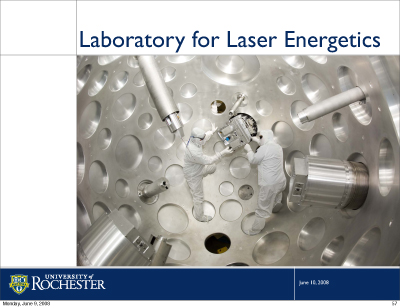
The next day, May 16, the University marked another important step in the effort toward attaining sustainable fusion, the ultimate source of clean energy, when we dedicated the Omega EP laser facility at our Laboratory for Laser Energetics or Laser Lab. Last year, the United States Department of Energy renewed its agreement to support the University’s Laser Lab for five years with $351 million in potential commitments.
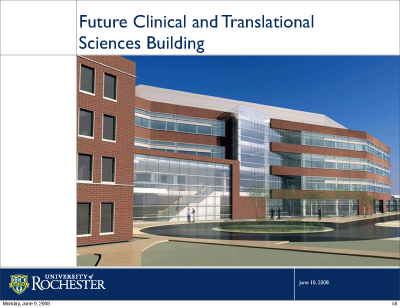
The Medical Center has developed a comprehensive strategic plan, that envisions a $500 million expansion in research, patient care, and education. One centerpiece of this plan is the new Clinical and Translational Sciences Building—for which New York State voted $50 million in funding in April of this year.
Much else occurs at the University of Rochester beyond the realm of research that strengthens our community.
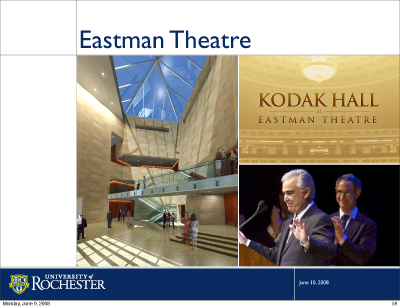
On April 11, 2008, for example, Eastman Kodak Company publicly committed $10 million to the renovation and expansion of the Eastman Theatre. This was a particularly meaningful gift given George Eastman’s role in the creation of the original theatre and the Eastman School of Music.
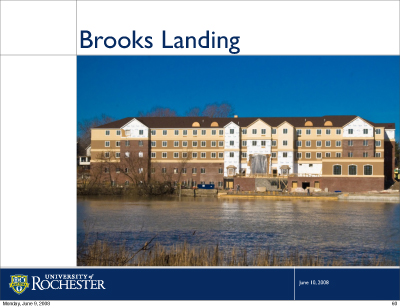
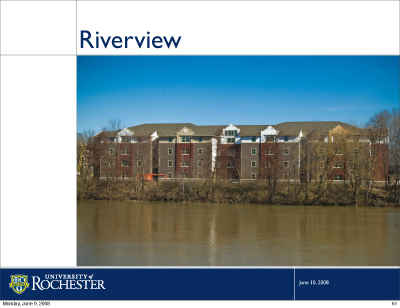
the new Riverview Apartments ready for occupancy by our students in August of this year.
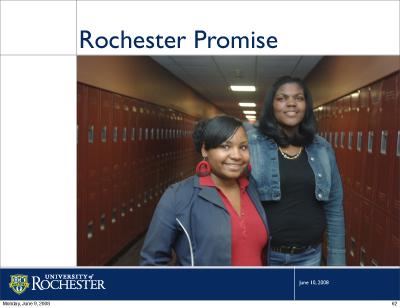
In December 2007, the College of Arts, Sciences and Engineering established the Rochester Promise, a new scholarship program under which initially up to 40 Rochester City School District students who qualify for admission will be awarded $25,000 for each of four undergraduate years to cover the cost of tuition.
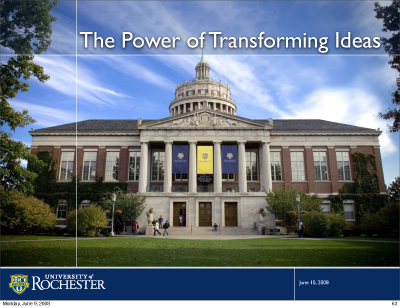
In Rochester we are building a knowledge-based economy led by universities and colleges. We are proud of the role the University of Rochester is playing in our community’s evolution.
We will succeed in this effort by building on great strengths as a community. Few cities combine the quality of faculty, the cultural, educational, and health resources, affordable housing, and scenic beauty as well as Rochester.
Few communities are as generous as Rochester. Rochester deserves kudos for its support of great new projects like the James P. Wilmot Cancer and the Eastman Theatre expansion and renovation.
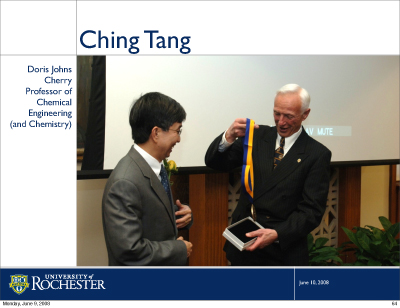
We are deeply grateful for your support of student scholarships, academic and clinical programs. Tonight I want particularly to thank those who have endowed professorships. There is no way to more effectively recognize a great teacher and scholar than an endowed professorship, academia’s equivalent to a knighthood.
Tonight I have emphasized the overwhelming importance of transforming ideas in building a great university. Transforming ideas can change the world. They are the consequence of great professors like those that I have presented to you tonight.
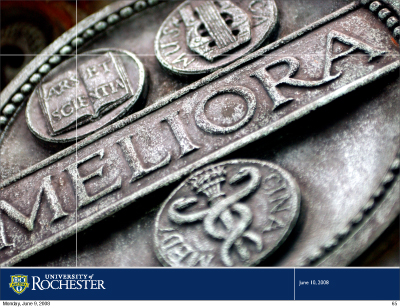
The larger significance of transforming ideas is clear. Ultimately the University of Rochester can play the type of role in the Rochester community that Stanford and U.C. Berkeley perform in the California bay area or Harvard and MIT play in Boston. We can be a research university that is the hub of a 21st century knowledge-based economy. In the years to come, the University of Rochester’s strategy of quality growth will strengthen our claim to be one of this nation’s leading research universities.
I am confident also that Rochester and the University of Rochester will succeed together at the paramount goals of job growth and economic development. The University is working hard to do its part. As of December 31, 2007, we provided employment to 21,764 individuals (counting full and part time jobs) and provided 18,671 full time equivalent jobs. This was equal to 8.7 percent of overall employment in the greater Rochester community. In 2007, the University was responsible for generating close to $2 billion in wages directly and indirectly, directly spent $464 million on goods and services, and spent another $175 million on capital expenditures.
And as I always like to close my remarks, we are just warming up.
